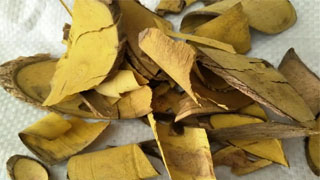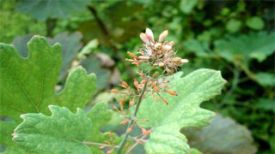
1. Alias
Tu Huangbai, Tu Huanglian, Ci Huangbai, Rat Thorn, Tu Huangqin.
2. Plant morphology
Ten major achievements of broad-leaved trees, evergreen shrubs, reaching up to 4 meters in height. The root and stem sections are yellow, with a bitter taste. Feathered compound leaves alternate, measuring 30-40 cm in length. The petiole base is flat and wide, covering the stem. The small leaves are 7-15 cm thick and leathery, ranging from broadly ovate to ovate in shape, measuring 4-12 cm in length and 2.5-4.5 cm in width. The tips gradually tip into sharp teeth, and the edges are curled back, with 2-8 sharp serrations on each side. The inflorescence is thick and robust, clustered at the top of the branches, with small clusters and dense growth; Sepals 3-9 whorls; Petal shaped; Petals 6, light yellow, with 2 shallow lobes at the tip and 2 nectaries on the inner surface near the base; 6 stamens, with cracked petals; Upper ovary, 1 chamber. The berry is oval in shape and turns blue black with white powder when ripe. The flowering period is from May to July, and the fruiting period is from November to January of the following year.
3. Origin distribution
Born in hillside forests and shrubs, cultivated. The top ten achievements of broad-leaved trees are distributed in Shaanxi, Anhui, Hubei, Hunan and other places. The Ten Great Achievements of Xiye are distributed in Hubei, Zhejiang and other places.
4. Harvesting and processing
Harvested year-round, sliced and dried.
5. Characteristics of medicinal herbs
Irregular blocks of varying sizes. The outer surface is gray yellow to brown in color, with obvious longitudinal grooves and transverse fine cracks. Some outer skins are smooth, glossy, or have residual petioles. The cut skin is thin, brown in color, and the wood is yellow. Several concentric rings and closely arranged radial textures can be seen. The marrow is darker in color and harder in texture. Odorless, bitter taste.
6. Sexual Taste Returning to the Classics
Cold in nature and bitter in taste. Return to the liver meridian, stomach meridian, and colon meridian.
7. Effect and Function
Clear heat, dry dampness, eliminate fire and detoxify. A heat clearing and dampness relieving medicine classified under the category of Qingre medicine
8. Clinical application
Use 9-5g, decoct in water and take orally; Apply in moderation for external use. Used to treat damp heat diarrhea, jaundice, redness and swelling of the eyes, stomach fire toothache, boils, abscesses, dysentery, and jaundice hepatitis.
9. Pharmacological research
The 25% water decoction of the roots of the Ten Great Branches of broad-leaved trees has a mild inhibitory effect on Staphylococcus aureus, Escherichia coli, and Pseudomonas aeruginosa in vitro. The salts of three alkaloids proposed from the Ten Great Achievements of Fine Leaves can promote spontaneous movement of isolated intestinal tubes at low concentrations, while at high concentrations, they can lead to increased tension and inhibition of movement.
10. Chemical composition
The top ten contributors to broad-leaved plants are berberine. The Ten Great Merits of Fine Leaves contain approximately 0.3% alkaloids, including berberine, jatrorrhizine, berberine, and trace amounts of magnolol; It also contains oxygen-containing berberine, palmatine hydrochloride, berberine, berberine, palmatine, and magnolol.
11. Usage taboos
People with weak and cold constitution should avoid using it.
12. Compatibility prescription
① Treatment for enteritis and dysentery: 15g of Eucommia ulmoides, 30g of Myrtle root, and 15g of Pomegranate leaves (or Phoenix tail grass). Boil it in water. (Zhejiang Medicinal Plant Chronicles)
② Treatment for hemorrhoids: 15g of medicinal wood, 2 pig feet, cooked to remove residue, eat pig feet. (Hunan Pharmaceutical Journal)
③ Treatment for redness and swelling in the eyes: 15 grams each of Gongqi wood and wild chrysanthemum. Boil it in water. (Jiangxi Herbal Handbook)
④ Treating fire teeth: 60 grams of merit wood. Boil water and frequently cough. (Hunan Pharmaceutical Journal)
⊙ The content of the article is for clinical reference only. Non TCM professionals are not allowed to test drugs.


